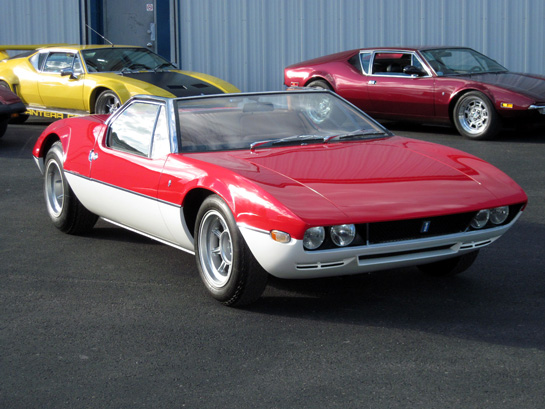
The elusive Mangusta Spyder. The VIN is 8MA512, making it the 7th chassis made. Photo courtesy of Mike Drew.
By Wallace Wyss
Meanwhile what to do with the Mangustas? After Ford turned thumbs down on the ‘Goose, DeTomaso connected with Kjell Qvale (pronounced SHELL QUE-VOLLEY) a successful car importer in downtown San Francisco.
Qvale had turned down a chance to buy the Mangusta after looking at it in pictures but was in Italy talking on a payphone when he saw the prototype roar by, probably with Jonathan Williams at the wheel. (Who knows if DeTomaso wasn’t stalking Qvale and waiting for an opportunity to roar past?)
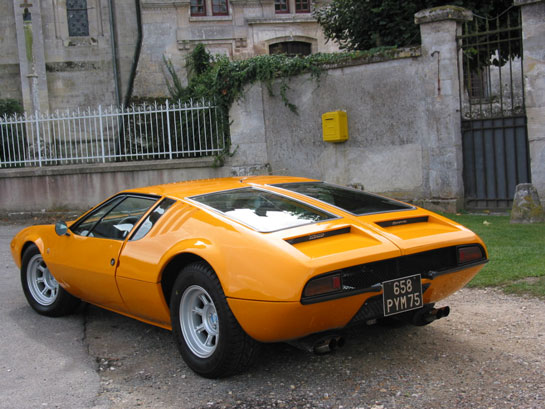
Mangusta MA1266 was built in 1971, and one of the last 25 Mangustas produced by the factory. Roland Jaeckel who distributes De Tomaso parts for Europe fully restored the car in the late 90's using mainly original factory parts. Car and photo courtesy Laurent Bouzoulouk
Qvale took out his next coin and called DeTomaso up and said he’d take it. He eventually sold over 280 of them but found out later that the Mangusta, as a piece of rolling sculpture, was beautiful. But as a piece of engineering, it was, uh, flawed. (Qvale went on to make his version of the Mangusta much later on Qvale’s Mangusta.
First of all, the engine and heads and intake manifold of the Ford 302 were all cast iron, the stuff of boat anchors. That made the car tail-happy. Secondly his beloved spine chassis, which had worked more or less in the four cylinder Vallelunga, was not torsionally stiff enough for the much more heavy (over 400 lbs.) V8 so the car would spin out once it reached a certain speed in what engineers call “steady state” cornering. And it was discovered the Renault-sourced steering rack was way too slow.
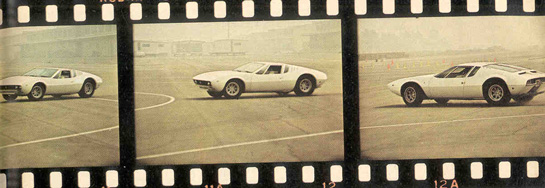
Sports Car Graphic’s film strip of the Mangusta spinning. They observed that it understeered and oversteered at just about the same time—a physically impossible feat. SCG December 1969
Sports Car Graphic took on the car on as a cause and diagnosed it. Their motor drive shots show the car’s squirrely behavior in a hard corner. It becomes clear the car flexes at a certain point around a corner and when it binds up and subsequently unflexes, it throws the car off line. The result is a violent shift from under-steer to over-steer, and even a skilled driver couldn’t catch it because of the slow steering. Williams probably caught it, but then he was a Grand Prix driver. The publisher of Sports Car Graphic was an extremely eccentric man named TC Browne who loved to tweak the nose of everybody in the business including automakers. He “borrowed” one of the first Mangustas and handed it over to Paul Van Vaulkenburgh, who was hired on their staff after being a test engineer at GM where he tested the rival GT40. So Van Vaulkenburgh was intent on showing how competent he was when he dissected the Mangusta in a three part series for the magazine.
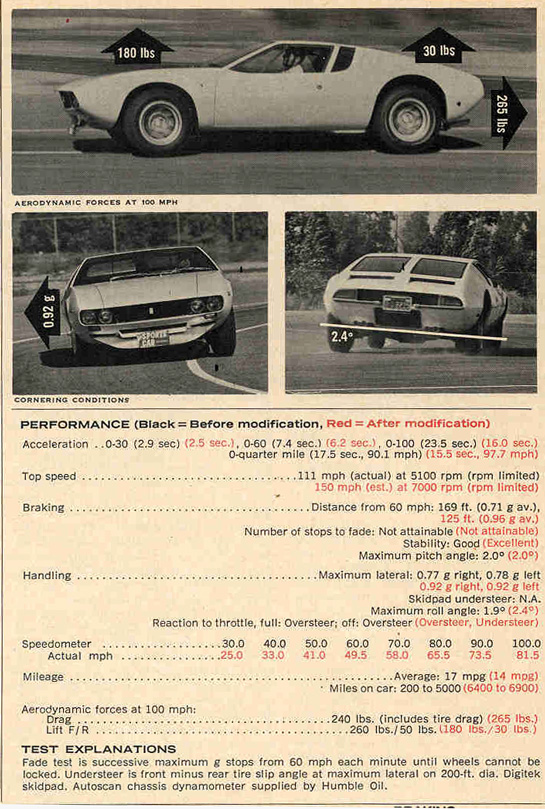
Sports Car Graphic data shows the first test figures in black and the second test in red. The magazine increased the horsepower and tweaked the chassis with Konis, new tires, and had Dick Guldstrand tune the suspension. But for them, the performance still didn’t match the looks.
A surprise to many is that the exotic looking Mangusta came to America underpowered. Factory specs listed the output of the standard 302 4V as 235 bhp @4800, and Gross Torque, 318@3200Ft-Lbs. SCG quoted 221 hp for the test car. The 302 engine had been sent to Italy as a sort of ecomony (to use SCG’s description) engine. So though it was durable, it had no revving capability beyond about 5100 rpm. The 302 wasn’t a bad engine but in the Mangusta it was choked up with smog pumps, poor exhaust design and weak cam. SCG added another 125 hp to their engine which then provided improved performance without twisting the frame.
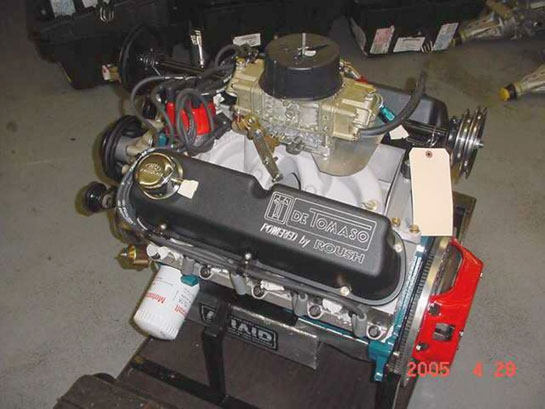
Bouzoulouk’s car was fitted with a 302 block prepared by Roush Industries and stroked to 342 cubic inches which was dyno test at 430 hp. Photo courtesy Laurent Bouzoulouk.
The high performance 289 used in the Mustang, rated over there at 271 hp, would have been better suited in America but only went in Euro-market Gooses. Over here, the engine was hard to get, mostly slotted for high performance Mustangs, Falcon Sprints, Comet Calientes, etc . Readers report that several of the first Mangustas came over with high performance 289s, but the factory started to produce the 302 in place of the 289 right about that time. DeTomaso was too cheap to cast an alloy block 289 (though one was made experimentally and Ford was horrified that when they dropped one, it broke into a 1000 pieces). It would have helped to have aluminum heads or even an aluminum intake manifold. But DeTomaso was following an ancient dictum of automakers: put the money on the outside. (See Note 1)
Only one fix for the rear weight bias was tried—aluminum gullwing lids instead of steel on the engine compartment.
Another episode in this tale of Lust in Lombardy was when Bill Mitchell, VP of GM in charge of styling, fell in love with the car. He ordered one, albeit with a Chevy 327. He angrily rejected the car when he found his rotund form wouldn’t fit in the car, which is ideal for someone about 5’6” tops and of slim build (like, DeTomaso or Williams not too coincidentally). He banished the car from his presence, feeling DeTomaso had deliberately created a car too small for him. (Mitchell told this to me when I’d have lunch with him at the Tech Center in the 1970s. Dick Ruzzin, the GM designer who ended up with the car, still owns the Mangusta Vette today.)
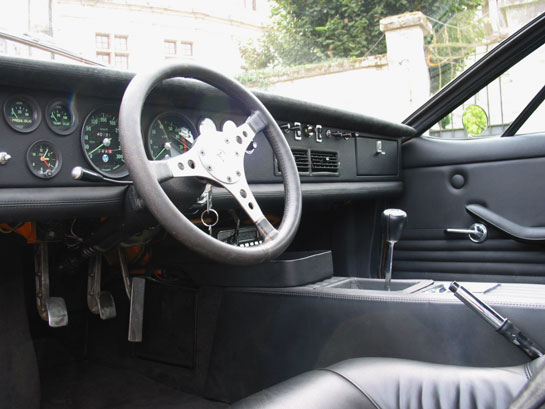
Steering wheel on this Euro version is the factory Grand Prix all leather model instead of the leather and wood wheel. A/C was upgraded on this car and works well. Note rocker switches. Car and photo courtesy Laurent Bouzoulouk.
And the car had another flaw—it was too low, possibly below the legal ground clearance limit of 5 inches. Any Mangusta driver will turn white at the sight of a speed bump. Hit one at 50 mph and you crack an almost irreplaceable transaxle case. The reason this didn’t happen in the Pantera was that they wisely flipped the gearbox upside down which gave the car more clearance, though of course it inhibited the Pantera’s cornering power.
The Mangusta was only “The Car to Own” in Hollywood for about 15 minutes and then the buyers went back to Maseratis and Ferraris. One of the most famous buyers by the way, which this writer met in a car body shop standing next to his smashed ‘Goose, was Dean Paul Martin, a pro tennis player, and movie star, son of Dean Martin. Martin had the dubious distinction of crashing two DeTomaso mid-engined cars, a Vallelunga just purchased for his younger brother Ricci, which he flipped, and a Mangusta which he wiped out almost to the windshield. He survived only to crash something too big to survive—a jet fighter while in the Air National Guard. (See Note 2)
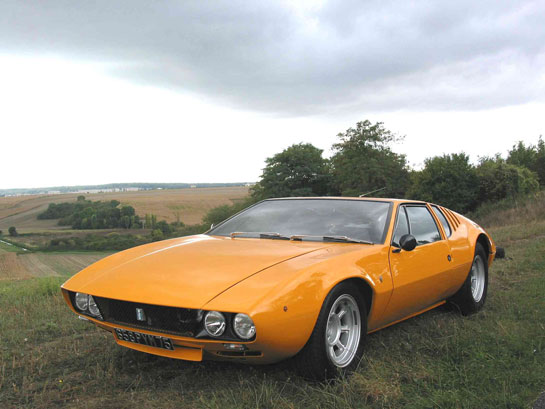
Owner Bouzoulouk reported that after the restoration he realized what surely was DeTomaso's dream with the Mangusta—plenty of power from the Roush 302 and due to a stiffened frame and better tires, excellent handling. Car and photo courtesy Laurent Bouzoulouk
All this being said, and despite all the brickbats you can throw at it, you can’t take away the fact that the Mangusta is a great Sunday morning ride to take to an event like a Cars n’ Coffee provided it is not too hot (the air conditioning was marginal) and the road’s not too wet and there’s no potholes or speed bumps on the way. Think of it as a self-propelled piece of sculpture. And one of Giugiaro’s greatest designs, equivalent to, say, his Maserati Ghibli coupe.
There was but one spyder, made for an auto show. It was found by an American. According to Mangusta enthusiast R. Terry Basey, the owner who had it restored at a cost of over $100,000 had turned down something closer to $200,000 some time before it was placed in an auction at no reserve. A hand-built Giugiaro design, mid-engined, and a one off should be a million dollars but again, it’s that low-born engine that works against it being considered by the High and the Mighty.
The value of your standard Mangusta coupe? Well, it’s hard to say. There are very clean ones in the six digits and very rough ones for about $50,000. What holds them back from a stratospheric price rise is the mundane ordinariness of the 302 engine, with its low redline of 5500 rpm and motorboat sound compared to the shriek of a Ferrari V12 or other “purebred” car engines where the engine is made by the same folks who make the car.
A strange phenomenon in the Mangusta world is that sometimes a new owner will buy one and spend an ungodly amount of money on it (one California buyer spent almost $200,000 at a Ferrari shop to restore his); way more than you could ever justify in the hopes of appreciation. Why? Because a disease that infects Mangusta owners is that they want to “make it right” which means doing the engineering that DeTomaso skipped over, ever so lightly, oh so long ago.
Note 1
According to one of our readers, DeTomaso got the best engine available at the time. “Don Coleman was in charge of the small-block Windsor engine program at that time (among other things, he was in charge of the GT40 small block development program for the ’68-69 Gulf cars, and the 351 in the Gulf Mirage), and DeTomaso asked him for Cobra-spec 289s. However these were discontinued by the time the Mangusta came into play, so Don offered up the next best thing he had.”
Note 2
Singer Dean Martin had two sons by his second marriage. Son Ricci was given a Vallelunga coupe for his sixteenth birthday which was almost immediately destroyed in an accident by his older broth Dean Paul. Ricci was given another new red Vallelunga, three weeks later. In 1969 Ricci bought a DeTomaso Mangusta.
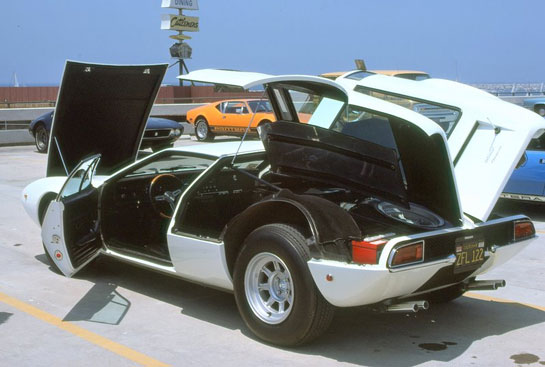
I am disappointed that Wally neglected to include my participation in the story, I own the Corvette L-79 powered Mangusta, built at the factory in 1969.
It follows:
It is funny that all those handling experts and magazine engineers did not figure out what was wrong with the Mangusta when it was tested. The magazines and experts could not figure it out. The engine had been in and out on some tests and they should have seen it immediately.
The Mangusta chassis is just like DeTomaso’s early cars. They were probably flexible too as you cannot find another mid-engine street or race car constructed with a key element of its structure that is flexible. There are two rear bridges, the small forward one could have been an early production correction attempt but an inadequate fix. The bridges link the two sides of the upper rear sub-frame carrying the transmission, it was hard mounted to the transmission and soft mounted to the frame, each with ONE SHOCK BUSHING AND BOLT per side. There you will find the flexibility.
That meant they acted like HINGES when SIDE force was applied to the upper rear control arms, resulting in the understeer / oversteer condition. The frame would parallelagram from side to side with force going from one wheel, through the flexible bridge to the wheel on the other side of the car. Camber would increase on one side and decrease on the other. Projecting the deflection of the soft bushing to the tire patch equals about 4 millimeters. that puts one wheel in ultra negative camber and the other in ultra positive camber.
I reversed it, hard mounted the bridge to the frame and hung the transmission from the bridge with soft mounts, actually three Corvette steering bushings. This is how mid-engine cars are done. My partner in all this was Werner Meier, an ex Gm chassis engineer who has a Corvette restoration shop. He did a great job, the car looks like it was built that way, he is the one who saw the problem.
Big improvement in handling at any speed. The feeling of weight bias is literally gone, even with a full tank of gas, I just do not think about it any more. The car feels very solid and glued to the road with no feeling of weight transition at any speed. The bridge modifications were done after installation of new motormounts and a re-build of my KONI shocks. The big improvements were all in the bridge changes. I am now able to lower my tire pressures front and rear and the car rides and handles just great.
Thanks for the chance to tell my story.
Excellent article. Always a delight to read from someone who had first-hand information.
Hi Dick Ruzzin, I agree, your story of first hand experience and your remedy to the problem that has plagued the car for all of these years really capped off a great read for me. Thanks for your contribution and thank your buddy Werner Meier also. What a shame they never came to him with the problem when the car was in production. It might have been a very different story for De Tomaso marque and the Mangusta as well. Great morning’s reading. Thanks to all.
Wally you need to write ‘A Critical Look, Lamborghini Miura’ !!
My first driving/passenger experience of a Mangusta was when i flew to Italy (March 2009) with my mechanic,bought the car unseen,drove it back to London (1000 miles) on half bald original Pirelli Cinturato’s from 1970,which did make driving in a straight line quite difficult !We drove a true 110mph,the car was quiet and comfortable.It is a one owner (Apple Green) car, very original with 30,000 miles and delivered directly from the hand of Mr De Tomaso.We now have fitted Avon CR6ZZ road legal race tyres.Did some brake work,fitted a skid/transaxle pan.The Camber,Toe In and Tracking is still completely out and we believe it left the factory that way?Roland Jaeckel told me at’ Classic Le Mans’ this year that the set up is basically the same as a GT40.Freddy Moss (Mangusta racer who apparentley beat Ferrari F40’s) said,i should fit a lightened flywheel ,and when i change the clutch have a faster racing rack made.I am looking in Europe for a LHD faster rack of similar size/fit to the existing Renault 4 (maybe Renault A110 ?? ).Thank you Dick for your very interesting comments regarding your Corvette L-79 powered Mangusta’s handling,which i shall look into.My shocks seem ok but are De Carbon/Corte +Cosso ?? Would Koni’s make such a difference ?? Mike Drew supplied me with spacers,which we reamed and fitted.The car was about 3″/4″ from pan to road…..v scary as our speed bumps/ potholes are legendary in the UK,not only did it raise the car but stiffened the suspension.On my short, slow run home the car felt much better.By the way Steve,i am a slim 5’10” and i fit my ‘Goose’ like a glove. My Mangusta won the ‘Auto Italia Concours’ , ‘Car of the Day’ at Stanford Hall this summer beating 100’s of very valuable Ferrari’s,Maserati’s and Lamborghini’s !!! What a fantastic car.Thanks guys.
Hello My comment in the first part was that no mangusta has rocker switches save for the electric window switches. These electric window switches were on all mangusta’s. There are no other rocker switches on any of the cars. Jerry McGlothin
The Mangusta leaves the Miura for dead. Can’t wait for a third installment on this car. Such a beautiful machine, it’s about time it gets the recognition it deserves. Giugiaro’s best efforts!! Glorified prototypes, all of them, that is what makes them so special. Well written, DeTomaso wasn’t that bad either. Let’s not forget that he went toe to toe with the best of them and left them bloodied on many an occassion.
Hello I have had 6 Mangusta’s,3 two headlight cars and 3 quad headlight cars ( two Euro cars and one USA delivery car) ,including the one that the person in CA paid big money for the restoration on an already nice car ( that car is now owned by a gentleman in Fresno). All my cars have performed to my satisfaction and I will always have a Mangusta in my collection. If I want screaming performance I can take my 10.5 sec quarter mile GTD 40 to the Friday night drags. Jerry McGlothin
To the Miura owner, I would love to write the Lambo Miura critique–send me your list of what you like and what scares you. I only drove one once, and that will be in the story.
Photojournalistpro@hotmail.com
I met Nuccio Bertone when I was assigned to be Director of Design for GM Europe. We had a contract with Stile Bertone to do advanced design work there. I would go once a month. On my second visit he showed me his lifes’ work, a portfolio of beautiful sporty and elegantly designed automobiles. It was a great experience and he told me his design story of the Muira, which I have written up if you are interested, or plan to do an article about the Muira. It was his favorite car design.
Ed Taylor in California, a retired GM designer, has restored a Muira and has had it for quite a while. He could probably write a good story as he has had it for a long time.
I would hope that you would not do a “critical” article but one that would be balanced and highlight the positive attributes of the car , from the owners experience as well as it’s historic significance. The owners experience is now available, it was not when the car came out and only press impressions were available. That perspective has limited value now.
You have not done a conclusion to your story about the Mangusta, how good was it? What were the clear positive attributes and what have so many owners done to correct the flaws to make them very good functional cars. The outstanding beauty supplied by Georgetto Giugiaro is a well understood given. You should include a technical analysis of the design.
DICK RUZZIN
MY R3ESPONSE TO THE HANDLING ANALYSIS:
“Sports Car Graphic took on the car on as a cause and diagnosed it. Their motor drive shots show the car’s squirrely behavior in a hard corner. It becomes clear the car flexes at a certain point around a corner and when it binds up and subsequently unflexes, it throws the car off line. The result is a violent shift from under-steer to over-steer, and even a skilled driver couldn’t catch it because of the slow steering.”
>Here Wally surmises that the car “flexes” and when it “binds up” it then “unflexes” throwing the car off line. To draw a dynamic conclusion based on photographic still shots is ludicrous. This does not make sense, it is a guess based on old information that has no logical conclusion.
_______________________________________________________
Sports Car Graphic’s film strip of the Mangusta spinning. They observed that it understeered and oversteered at just about the same time—a physically impossible
feat.
It understeered and oversteered at JUST ABOUT the same time.
>I guess that means that it was under-steering strongly and something happened that caused it to over-steer… instantly.
No explanation of the observation is offered by Sports Car Graphic. If the car was on a constant turn radius with increasing speed then I think that as forces built up in the turn, as pressure increased on the outer upper control arm that controls the camber, the small bridge bushings could have deformed and caused the outboard camber to increase and the inboard camber to decrease. If the bushings deformed quickly under the pressure then the resultant camber change could have been what caused the instant switch from under-steer to over-steer.
Sports Car Graphics lack of a conclusion based on their observations and Wallys assumptions do not explain what went on because there was no conclusive evidence available that was created as a result of change and further testing.
This adds to the handling myth that follows the Mangusta.
The way to eliminate the deformation of the bridge bushings is to eliminate them from the suspension system.
Dick Ruzzin
I am new to this forum and I do not wish to hog the comment page, but the article by Wally is about a car I have owned for over 41 years. I know it well, every bolt and nut, inside and out.
Someone wrote that it was a good article. It was not. That is not only my opinion but also that of other informed Mangusta owners. First of all, to publish a CRITICAL article forty fours after the car came out and just offer an old collection of printed information does nothing to allow interested parties a real understanding of the car today. The article casts negative aspersions on DeTomaso and those working for him to create and build the mangusta as well as the spirit of the Italian motor industry. Hard work by many is treated as material for some kind of comedy routine. This is unforgivable. It offers nothing new, and is mostly the same old press commentaries that have been there for forty years. This sour attitude toward the Mangusta does a disservice to current owners of the cars and to those who feel enthusiasm for it for whatever reason and who hope to own one in the future.
I encourage VELOCE to do a new well crafted up-to-date article that really defines it in history past and present, its strengths and weaknesses historically, with commentary from the many enthusiasts that have owned one or who own one now. I am speaking of people like Mike Drew, Dana Hansen, Steve Liebenow, Daryl Adams and others who are known in the DeTomaso community as enthusiasts and expert in their understanding of what the car is.
DICK RUZZIN 10-10-2010
Another excellent article!
While I knew little about the Mangusta prior to reading them, what these pieces have reinforced for me is how the human element played such a big part in how these cars were developed. Had the chassis solutions applied by Mr Ruzzin been on the car initially we can only imagine what the perception would be of the car today.
While today’s exotics are much more reliable and refined it seems that the eccentricities that could make a car appealing (or annoying) have been removed from the process.
I am not sure that is a good thing!
Thank you all for the articles and the comments – it has been a pleasure to read them.
We spec’d out and ordered three new Mangustas direct from the factory in ’69 for Automobiles of Italy here in Tulsa. They handled like Buicks at low to medium speec if we used the tire pressures printed on little pieces of tape that were stuck on over the printed pressures in the owner’s manuals. Usin the “non-American” pressures made the cars fun to drive. In the wet the fronts would lock up immediately so some people cut off half of the front brake pads for a little less bias. The 5,100 rev limit, I think, was due to a points spring so weak that you could open the points easily with the nail on your little finger. I was 6’1″ and could nestle in comfortably; potential buyers didn’t like how close your forehead was to the sun visor. I had a Miura, delivered in August of ’67, which I ran in a few races in the ASR class of SCCA. Two laps=no brakes. The oilpressure gauge would slowly sink from 10atm to near zero in the sweeping righthand turn 1 at Savannah. The cause was the same thing that scared us with the Stratos at Daytona in the horseshoe: centrifugal force on the gauge needle!l I overheard a conversation on the same subject in the Alfa pits at Sebring with their two-liter sportscars.l I think (my Italian was better then) that one of the engineers said don’t worry about the oil pressure–the rest of the car isn’t going to last very long in any case. Surtees was scheduled to drive one but left before the race, possibly because a wheel came off one of the cars in practice…
MANGUSTA… What a beautiful car…. but… I would have to characterize the car as a Prototype. Great to look at… but not to drive.
Purchased my first one in the mid 70’s from Miami Florida. The car was a beauty. The owner told me he had the car just serviced, also told me that he needed something that he could drive to work.At the time, I didn’t know what he was refering to.
I was happy… to say the least. She was beautiful… I had to have her…so… I took the PLUNGE. Put the title in the glove box, started her and was cruising to the Sunshine State Parkway. I wanted to savor every moment… this was the Honeymoon period. This Beauty felt really wierd though, but… I figured it was my lack of experience with the Detomaso Mangusta. The car was a quad light 1969 in a really nice Bronze color. The interior was original black and WOW the leather was so nice and the smell was fantastic. I Stopped at the Service Plaza to fill up … this thing seemed to be so different than the Pantera. This car was wandering all over the road…… I think holding the steering wheel straight.I hit the brakes… she darts right…I hit the brakes … she darts left. Give it gas… the nose lifts… let off the gas … the car shimmys. While I was driving the Goose ,I hit a pot hole and thought I lost a filling. The car definatly was bottoming out. I looked under the car and there was a massive skid plate from the rear driver compartment to under the trans and went to the tail of the square tube frame. The skid plate was grooved hundreds of times. ( she regularly bottoms out )
I opened the rear wing to fill up and the people at the service plaza went wild. I filled the car with fuel , checked the oil, then was on my way.
I think I went 50 miles north of Miami and heard something that did not sound user friendly. It was a really big bang and at 60 mph the car then sounded like she was skidding. I looked to the right and saw my rear wheel cruising down the Highway towards the grass. I immediatly steered the car to the right and the car skid to rest just inside the Emergency lane. My first thought was… the wheel lugs were loose and vibrated off. Then when I retrieved the wheel it had the stub axel mounting plate with all 4 lugs attached and the car was DONE for this journey. So much for that Honeymoon period. It turned out the stub axels were machined improperly from the Factory.
I owned a bunch of these cars including the only Race Mangusta, I lost a good friend in a 70 model goose( because of handling). The Mangusta is for show… for a cruise around town.. for investment….but not for speed or distance. It is more of a Prototype .. a Design Exercise..a Pioneer of the mid engine Exotic car along with Miura and GT40. Above all …The Mangusta is Beautiful and Exclusive.
THE AUTHOR COMMENTS: The lack of engineering follow through is what damned DeTomaso as far as attaining legendary
car builder status. Let me cite this from a Vallelunga owner. He lost control of the steering and then realized that the steering wheel was held onto the steering column by a mere set screw. Imagine something as safety related as steering being held together with a set screw! But, hey, that car unloosened the Haskell family pursestrings sowith Mr. Slick Daddy Argentine it was all in the way you did the Tango….
To Dick Ruzzin: Dick, I really agree with your comments and respect your depth of knowledge concerning the Mangusta. Perhaps it would be better for you, as an experienced owner, to write the article instead of Wally. You have first hand knowledge, probable access to photographic content, access to other owners for their comments and opinions, it just makes better sense to me than Wal writing it.
I have really enjoyed reading about your impressions and improvements and imagine so have many others. And no, I don’t think you hijacked the thread at all, you made a lot of good points but now, how about a fully blown expose in support of the Mangusta. Put to bed once and for all, all that negative, ill-informed, out-of-date criticism and tell people all the good news about this great car. I know, I’d love to hear your story.
Guy Anderson, could you please email me – I have a question about your car- my Goose was bronze too. Imagcoll@aol.com Many thanks
THE AUTHOR COMMENTS:
I am certainly impressed by the defenders of The One True Faith (which I gather is the Mangusta). But I don’t think “negative, ill-informed, out of date criticism” is accurate either. How can criticism be “out of date’ when in the time when the car was being sold, Sports Car Graphic’s GM-trained engineer showed the car was unstable in steady-state cornering (going around a circle at ever increasing speeds.). The British have a word called “fettling,” which means fine tuning a mechanical object until it works as originally planned. The Mangusta took a lot of fettling after an owner took delivery, to fix things that should have been perfected in the development process.. I think it was a matter of priorities–DeTomaso was trying to impress his in-laws, who held the pursestrings to the money he needed to make it to the automotive big-time, and the way to impress them was to get the car out in a hurry. I have no doubt that, given the time and the money, a Mangusta can be sorted out (“fettled”) to be more reliable, predictable and marginally safer, but I am talking about the way the car came when new. DeTomaso could have spent more money on developing the car but he was off to the next thing (which was to convince Ford to put the DeTomaso 351/aka Pantera, in production so he couldn’t waste a minute on a car being phased out. There is an old saying in Detroit “Never buy a car in its first year ” alluding to the fact there may be flaws that aren’t known yet. Well, with a Mangusta you could extend that to saying “Never buy a Mangusta in its first several years.”
Don’t get me wrong, I like DeTomaso who I see as a sort of madcap genius, totally undisciplined though downright creative, or I wouldn’t have written two books on him. It’s just that I am not a public relations man, or even latter day public relations man, for him or his firm, and don’t want to sugar-coat a car with flaws despite its beauty. Though I like Italian cars, I am beholden to no particular marque and if a car has flaws, even if I know someone with money can get that flaw mitigated, I am still going to point out the flaw exists. (For example, the early Intermeccanica Italias had inadequate front suspensions). To me the Mangusta is like some beautiful women I have met in far-off ports of call who looked worth the risk of going out with, but you knew that if you spent too much time with them, you could end up dead.
Hey Dick, easy on me, boy. I am not basing my opinions of the handling
of the Mangusta on something I read in a magazine, I was actually working in Los Angeles for Petersen Publishing back then in the ’60s, off an on, and knew Van Vaulkenberg personally and talked to him about the car, so heard his opinions from the horse’s mouth. He had previously tested the GT40 for GM (who had bought a GT40) so he was easily qualified to evealuate a mid-engined car. and even the phrase “out of date criticism” is a contradiction in terms because any historian wants to quote opinions that were voiced in the car’s original era. For instance, the 289 Cobra had a lot of criticism at the time of its handling but I think it got the job done and today there are no complaints about its handling but it is part of its history that originally it was criticized. And you made me remember another De Tomaso quality control story. The head of Ghia design told me that when he went back to Ghia after Ford bought it, there was an old Vallelunga around the shop but his employees were scared to drive it because, on occasion, the wheels fell off…
This is a suggestion for a quicker rack and pinion to help out Jonathan Root’s inquiry.
I owned a quad headlight Goose in the ’70s, that I restored myself, including engine mods, and a quicker rack to try and help catch the rear end whenever it
decided that it liked being in front of the driver, rather than behind.
The rack that I chose was from a Datsun 240 Z . This improved the lock to lock from the (dismal) original 4-3/4 turns to just 2-1/2 turns .
I don’t remember how much work was involved, but I don’t think it was that hard, because I’m basically lazy by nature, and would have chosen an easy solution.
On the handling issues; having owned that Mangusta, and then 3 Panteras after that, I can say that I loved the looks of the Goose, but on the race track at club events that were co-sponsored by the Los Angeles Ferrari and POCA clubs, there was no comparison between the Mangusta’s [lack-of] handling, and the Pantera’s.
A case in point: At an event at (the now defunct) Ontario Motor Speedway, I enjoyed the thrill of spinning the Goose fifteen times throughout the day.
Doing similiar events for the next few years in Panteras, I never spun them once.
As a final note, I enjoyed the article very much, as it brought back memories of terrifying Wally when he was a passenger in my race-prepared Pantera while drifting around turn nine at Riverside Raceway…
To whomever writes any more articles regarding Mangustas. Could you please state the facts correctly. No Mangustas have been proven to have came from the factory with a 289Hipo motor . Other than the first 5-6 preproduction examples. And this includes the First glass roof Protitipo from the 1966 Turin Salon, as it was a push-car (non-running) , until 1993. So you cannot really say this example came with anything originally (by the way, originally , in the non-running form. It had a Detomaso overhead cam motor installed , from which the shorybloch was loosely based on the ford smallblock ).
This is just plans/hype, which has been repeared over & over , for 40 plus years
About the Prototipo, the gold one.
A car that looked looked that lapped the Montecarlo track in 1967 or 68 carrying Princess Grace (kelly). The glass sunroof was put in, I was told, so that the attending crowd could see her from the stands. That would mean it was made into a running car before 1993.
I was at the DeTomaso factory in 1993 and it was not there.
DICK RUZZIN
To defend Van Vaulkenberg, he was working to a schedule. He did manage to bolt a displacement transducer on the rear suspension (pretty high tech in those days) and discovered when the car spun the outer rear suspension was extending, not compressing (i.e. jacking like a 1960 swing axle Corvair), and attributed this behavior to chassis flex.
I am 6’ 1” and fit the Mangusta perfectly. Taller and you will bump your head, shorter and you have to run the seat forward which results in your head hitting the top of the windshield (and the center review mirror being behind you).
The Mangusta is does have very stiff springs, so the ride on rough roads is not pleasant. The rear anti-roll bar is also very husky. I have often wondered if fitting a softer rear anti-roll bar would reduce the tendency to over-steer.
It has been commented that the Mangusta’s brake balance is over biased to the front. I installed an adjustable proportioning valve on the front brakes and it seems a cheap and effectively solution. Proportioning valves on the front are not recommended for racing as if you brake hard enough you may get rear lock up, but it works fine on the street.
I am about to install a proportioning valve on my Mangusta, I have everything now except two brake line adapters.
The front brakes do lock up, especially now since I have redone my calipers. With 57,000 miles I still have the original, obviously very hard, pads. The funny thing is that the pads are only about half worn.
A proportioning valve is a tool, to be used wherever less braking force is required, street or track.
Dick Ruzzin
For Dick Ruzzin,
Would you mind to send me your email, I have acouple questions regarding your Mangusta.
Best
Johannes Torpe
Johannes Torpe,
email me at >dickruzzindesign@aol.com<.
If it is not too late, commenting about the De Tomaso Mangusta.
DICK RUZZIN / 5-12-2013
Hi all,
My family has owned Mangusta 8MA 520, the 10th Mangusta built, for over 30 years. I restored the matching-numbers car and I can tell you that it does indeed have a Cobra-spec HiPo 289 with studded rockers, a hot camshaft, and a fabricated exhaust manifold. The rebuilt unit made over 320bhp on the engine dyno with nothing more than a cleanup to the inlet ports. It revs strongly to 7000. Although not many know about it, the assertion above that the early Mangusta’s had steel engine covers is also true, as does mine. I addition the ZF ‘box has a sequential action, very unusual but a feature seen on the boxes used in GT 40s to eliminate mis-selection. I noted a few Mangusta issues however:
1. The sump only contained about 2 litres of oil, so obviously I enlarged it.
2. Ground clearance isn’t an isue on the correct tyres. Mine runs on Dunlop M-section racing tyres. It looks abosolutely perfect too as they are both higher in profile and wider at the back. The car was absolutely designed to have these on it.
3. Given the above, the car handles pretty well, but has the typical tendancy of a mid-engined car to yaw easily. If you are not used to that, given the slow steering, it can be unsettling, but at the same time it makes the car agile. Try letting the steering self-centre coming out of a slide…
4. The clutch slave required re-engineering a it lacked sufficient stroke.
5. It had a very crude rear brake proportioning valve. I’m not sure it actually worked, so I upgraded that.
Hope the insights are useful and interesting.
Well at least enough realize the spine flex is not the heart of spooks in the ass. Wallace, when i owned 1148 in 79-82, i read Your book on Shelby’s and “also rans” didn’t care for you then…read super ford’s and thought here’s some one who adjusts himself to what is he tries to sell…like a polytishian..flip flop, flip flop flip flop…..fortunately there are critical thinkers left in the world who can determine for themselves and not be led by what get’s printed. Hail the Mangusta…Truly Unique…….. and now you piss me off again with your canned sarcastic non’wit
For all Mangusta “lovers” A new model car